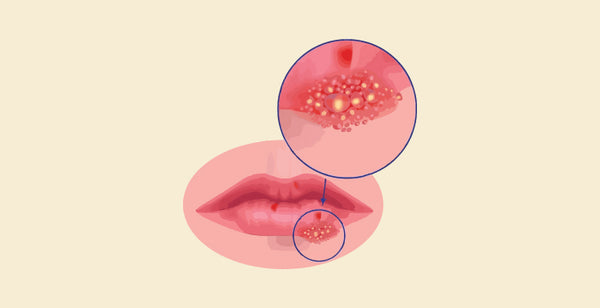Difference between Dermatitis Herpetiformis vs Herpes: Dermatitis Herpetiformis (DH) and herpes are two different diseases affecting the skin but having similar symptoms caused due to different reasons. DH is an autoimmune disease triggered by gluten ingestion that presents as an itchy rash with tiny red bumps or blisters on the skin. This condition is associated with celiac disease and requires strict adherence to gluten-free eating habits.. The underlying causes and therapies for Herpes and DH differ greatly, despite some overlap in symptoms.
Difference between Dermatitis Herpetiformis and Herpes
Dermatitis Herpetiformis (DH) is an inflammatory skin disease that is brought on by gluten ingestion. It is frequently linked to celiac disease and manifests as a persistent, itchy rash with little red bumps and blisters. The table below provides the differences between Dermatitis Herpetiformis and Herpes.
|
Aspect |
Dermatitis Herpetiformis |
Herpes |
|
Cause |
Autoimmune reaction triggered by gluten sensitivity |
Viral infection caused by Herpes simplex virus |
|
Symptoms |
Intensely itchy, blistering skin lesions |
Painful blisters or sores on affected area |
|
Affected Areas |
Typically elbows, knees, buttocks, scalp |
Lips (HSV-1, oral Herpes) or genitals (HSV-2) |
|
Itching |
Severe itching often precedes appearance of lesions |
Tingling, itching, or burning sensations |
|
Diagnosis |
Skin biopsy with granular IgA deposits |
Clinical presentation, viral culture, or blood tests |
|
Treatment |
Gluten-free diet, medications like dapsone |
Antiviral medications, topical treatments |
Browse The Best Scrubs Collection!
What is Dermatitis Herpetiformis?
Dermatitis Herpetiformis, or DH, is a type of autoimmune disease. It makes your skin extremely itchy and leads to blisters. DH occurs when a person has a sensitivity to gluten. It's connected to celiac disease. When the body encounters gluten, it reacts negatively. It creates antibodies known as IgA. These antibodies travel to the skin and result in DH. DH typically appears in areas like the elbows, knees, buttocks, lower back, and scalp. You could see groupings of tiny, red bumps and blisters. To manage DH, a very strict gluten-free diet is necessary. Drugs such as dapsone can be beneficial too. They work to decrease inflammation and itching.
Causes of Dermatitis Herpetiformis
- Genetics: There is a significant hereditary component to DH, with those with particular genetic markers (HLA-DQ2 and HLA-DQ8) having a higher risk of developing DH in addition to celiac disease. These genetic markers predispose people to mount an aberrant immune response to gluten and are important in immune system control.
- Immune System Dysfunction: DH, like celiac disease, is an autoimmune illness where the body's tissues are wrongly attacked by the immune system. When someone has DH, their immune system attacks the skin, causing inflammation and the development of distinctive skin lesions. Gluten consumption causes this aberrant immunological response in those who are sensitive.
- Gluten Sensitivity: A key factor in the development of DH is gluten, a protein present in wheat, barley, and rye. Gluten consumption causes an immunological reaction in people with DH, which results in skin irritation and blister formation. The main treatment for DH is to avoid gluten; maintaining a rigorous gluten-free diet can aid in symptom management and help avoid flare-ups.
- Environmental Variables: Although immunological system malfunction and genetics are the main causes of DH, environmental factors may also be involved. Stress, infections, drugs, and hormone fluctuations are a few examples of factors that might affect the intensity of DH symptoms or cause flare-ups in those who are vulnerable.
Symptoms of Dermatitis Herpetiformis
- Itchy Skin: The most prevalent sign of DH is pruritus, or itching, which can be severe and enduring. The itching is usually worse at night and is frequently described as burning or stinging.
- Skin Rash: Small, red pimples and blisters make up the characteristic rash associated with DH. These lesions can occur on the elbows, knees, buttocks, lower back, scalp, and back of the neck. They are usually symmetrically distributed. Other body parts could also be impacted by the rash.
- Blisters in Groups: The DH-specific skin lesions frequently take the form of tiny, fluid-filled blisters arranged in clusters or groups.
- Burning or Stinging Sensation: People with DH may feel as though their skin is burning or stinging in addition to itching in the affected areas.
What is Herpes?
Herpes is a viral infection produced by the Herpes simplex virus (HSV), of which there are two main types: HSV-2, which is primarily linked to genital Herpes, and HSV-1, which is commonly associated with oral cold sores. Herpes is extremely contagious and spreads by direct contact with bodily fluids or infected skin. The virus stays in the body for the duration of an infection and reactivates regularly to create excruciating sores, itching, and inflammation. Antiviral drugs can treat symptoms even though there is no known cure, and safe sexual practices can lower the chance of transmission.
Causes of Herpes
- Direct Contact: The most common mode of transmission is through direct contact with an infected person's skin or bodily fluids, such as saliva, genital secretions, or lesions. This can happen when you kiss when you have sex, or even when you share personal things like razors or towels.
- Sexual Interactions: HSV-2 is mostly linked to genital Herpes and is typically spread through sexual interactions, such as oral, anal, or vaginal sex with an infected partner. It's crucial to remember, though, that oral-genital contact can also result in genital Herpes caused by HSV-1.
- Skin-to-Skin Contact: Even in the absence of symptoms, skin-to-skin contact with an infected area can transfer the virus. This implies that even in the absence of lesions, Herpes can still spread.
- Vertical Transmission: If a mother is having an active outbreak at the time of delivery, there is a chance that her kid will contract HSV from her. Neonatal Herpes is the term for this condition, which can have dangerous effects on the infant.
Symptoms of Herpes
There are two main types of Herpes viruses: Herpes simplex virus type 1 (HSV-1) and Herpes simplex virus type 2 (HSV-2). The location of the infection and the kind of
Herpes virus might affect the symptoms.
Herpes Simplex Virus Type 1 (HSV-1):
- Cold sores or fever blisters: These are the most common symptoms of HSV-1 infection. Usually, they manifest as tiny, fluid-filled blisters or sores on the lips, mouth, or cheeks.
- Tingling or burning sensation: Some persons may feel tingling, itching, or burning in the affected area before the development of cold sores.
- Swollen glands: Neck or other nearby lymph nodes may swell in response to an illness.
- Pain or discomfort: Cold sores can cause pain or discomfort, particularly if they break and turn into ulcers.
Herpes Simplex Virus Type 2 (HSV-2):
- Genital sores: HSV-2 is the main cause of genital Herpes, which is characterised by the formation of painful blisters or sores in the genital region, which includes the penis, vulva, buttocks, and anus. Women may also develop these lesions on their cervix.
- Itching or tingling: People infected with HSV-2 may have burning, itching, or tingling sensations in the vaginal area before the development of sores. This is similar to HSV-1.
- Urinary discomfort or pain: Having genital sores can make it uncomfortable or painful to urinate.
- Flu-like symptoms: During the first outbreak or repeated episodes of genital Herpes, some patients may feel symptoms like fever, headache, muscular aches,
and exhaustion.
Shop Best Lab Coats From Here!
Similarities between Dermatitis Herpetiformis and Herpes
- Skin Lesions: Vesicles or blisters can be the hallmark of both Herpes and Dermatitis Herpetiformis skin lesions. These lesions are usually tiny, irritating papules or vesicles that are gathered together in Dermatitis Herpetiformis.
- Itching: Herpes and Dermatitis Herpetiformis both frequently present with itching as a symptom. Both illnesses can have very itchy lesions that make the affected people uncomfortable and distressed.
- Chronicity: Either of the two disorders may have recurrent flare-ups or outbreaks. The rash of Dermatitis Herpetiformis frequently waxes and wanes over time, generally in reaction to dietary factors like consuming gluten. Herpes infections also have an erratic recurrence rate, with outbreaks brought on by a variety of conditions like stress, disease, or hormonal fluctuations.
In conclusion, even though both Herpes and Dermatitis Herpetiformis cause skin lesions, their causes, triggers, and course of treatment differ. Herpes is a viral infection brought on by the Herpes simplex virus, whereas DH is an autoimmune disease linked to gluten sensitivity.
Order the Best Jogger Scrub From Here!















